Clinical Manifestations & Opportunistic Infections - Health[e ...
Clinical Manifestations & Opportunistic Infections - Health[e ...
Clinical Manifestations & Opportunistic Infections - Health[e ...
Create successful ePaper yourself
Turn your PDF publications into a flip-book with our unique Google optimized e-Paper software.
<strong>Clinical</strong> manifestations<br />
and opportunistic<br />
infections in<br />
HIV infection<br />
July 2009<br />
Dr. Evelien de Jong
<strong>Clinical</strong> manifestations<br />
1. Acute HIV-1 1 infection<br />
2. General manifestations<br />
3. HIV-associated Skin and Mucocuteneous<br />
diseases<br />
4. Oral manifestations of HIV<br />
5. HIV and Tuberculosis co-infection<br />
6. PCP
29 year old man, no medical history<br />
2 weeks of malaise, myalgia and since a couple days<br />
a rash<br />
Four weeks ago unprotected sex<br />
Complaints of severe fatigue, no weight loss or<br />
mouth sores<br />
1week ago his GP gave him amoxicilline with no<br />
effect<br />
Physical exam: temperature of 38.3 C, diffuse<br />
adenopathy, maculopapular rash
Rash
What is your diagnosis?<br />
1. Mononucleosis infectiosa<br />
2. Acute CMV-infection<br />
3. Acute HIV-infection<br />
4. All of the above are optional<br />
5<br />
0% 0% 0% 0%<br />
0<br />
0<br />
Mononucleosis infec...<br />
Acute CMV-infection<br />
Acute HIV-infection<br />
All of the above are o...<br />
30
What is your diagnosis?<br />
1. Mononucleosis infectiosa<br />
2. Acute CMV-infection<br />
3. Acute HIV-infection<br />
4. All of the above are optional
Test results<br />
<br />
<br />
HIV RNA: 63.700 copies/ml<br />
HIV antibody: negative<br />
<br />
<br />
What is your diagnosis?<br />
Acute HIV-infection
How long is your diagnostic window?<br />
The current HIV-antibody<br />
screening tests are able to<br />
recognise almost 99.5 % of HIV– infections……<br />
A. 2 weeks<br />
B. 1 month<br />
C. 3 months<br />
D. 1 year<br />
….after primary HIV infection<br />
0 van 5<br />
2 weeks<br />
0% 0% 0% 0%<br />
1 month<br />
3 months<br />
1 year<br />
30
How long is your diagnostic<br />
window?<br />
The current HIV-antibody<br />
screening tests are able<br />
to recognise almost 99.5% of HIV-infections<br />
infections…<br />
A. 2 weeks<br />
B. 1 month<br />
C. 3 months<br />
D. 1 year<br />
…..after<br />
primary infection with HIV
Typical Course of Primary HIV<br />
HIV RNA<br />
1 mil<br />
100,000<br />
10,000<br />
1,000<br />
100<br />
10<br />
Exposure<br />
HIV<br />
RNA<br />
P24 +<br />
Symptoms<br />
Ab<br />
+<br />
_<br />
HIV-1 Antibodies<br />
0 3 14 21 28 35<br />
Days
Typical Risk of Unprotected<br />
Exposures<br />
Estimated Average Per Contact Transmission Risk (%)<br />
Shared Needles 0.7%<br />
Occupational Needlestick 0.3 %<br />
Male to female, vaginal sex 0.2%<br />
Female to male, vaginal sex 0.1%<br />
Insertive anal sex 0.1%<br />
Receptive oral sex with male 0.03%
Day 0<br />
Day 0-2<br />
Exposure to HIV at<br />
mucosal surface (sex)<br />
Virus collected by<br />
dendritic cells, carried<br />
to lymph node<br />
Day 3-11<br />
HIV replicates in<br />
CD4 cells, released<br />
into blood<br />
Day 11 on<br />
Kahn JO, Walker BD. N Engl J<br />
Med. 1998;339:33-39.<br />
Virus spreads to<br />
other organs
Which one of the following statement is true<br />
regarding acute HIV infection?<br />
A. Less than 5% of persons who acquire<br />
HIV develop an acute illness<br />
B. More than 80% of patients with acute<br />
HIV present with an aseptic meningitis<br />
C. Patients recently infected with HIV<br />
typically have plasma HIV RNA levels<br />
greater than 50.000 copies/ml within 4<br />
weeks of acquiring HIV<br />
D. An HIV-RNA level of 800 copies/ml<br />
and a negative HIV-antibody test<br />
would be diagnostic for an acute HIV<br />
infection<br />
Less than 5% of per...<br />
0% 0% 0% 0%<br />
More than 80% of pat...<br />
Patients recently infe...<br />
An HIV-RNA level of 8..<br />
0 van 5<br />
30
Which one of the following statement is true<br />
regarding acute HIV infection?<br />
A. Less than 5% of persons who acquire HIV develop an<br />
acute illness<br />
B. More than 80% of patients with acute HIV present with<br />
an aseptic meningitis<br />
C. Patients recently infected with HIV typically have<br />
plasma HIV RNA levels greater than 50.000 copies/ml<br />
within 4 weeks of acquiring HIV<br />
D. An HIV-RNA level of 800 copies/ml and a negative<br />
HIV-antibody test would be diagnostic for an acute HIV<br />
infection<br />
Northwest AIDS Education and Training Center and the University of Washington
Primary HIV Infection: Signs &<br />
Symptoms<br />
80-90% of patients will be symptomatic<br />
A mononucleosis-like like illness of non-specific<br />
signs and symptoms<br />
Signs and symptoms typically begin 1-41<br />
4 weeks<br />
post-exposure<br />
High index of suspicion is critical<br />
Kahn JO, Walker BD. N Engl J Med. 1998;339:33-39.<br />
Schacker T, et al. Ann Intern Med. 1996;125:257-264.
Primary HIV Infection:<br />
Common Signs & Symptoms<br />
fever<br />
86<br />
lethargy<br />
74<br />
myalgias<br />
rash<br />
headache<br />
pharyngitis<br />
59<br />
57<br />
55<br />
52<br />
N = 160 patients with PHI in<br />
Geneva, Seattle, and Sydney<br />
adenopathy<br />
44<br />
0 10 20 30 40 50 60 70 80 90 100<br />
% of patients<br />
Vanhems P et al. AIDS 2000; 14:0375-0381.
Primary HIV Infection:<br />
Other Signs & Symptoms<br />
aseptic meningitis<br />
24<br />
oral ulcers<br />
15<br />
genital ulcers<br />
10<br />
thrombocytopenia<br />
45<br />
leukopenia<br />
40<br />
transaminitis<br />
21<br />
0 20 40 60 80 100<br />
% of patients<br />
Kahn JO, Walker BD. N Engl J Med. 1998;339:33-39.
Oral Ulcers in Acute HIV Infection<br />
From: Walker, B. 40 th IDSA, Chicago 2002.
Genital Ulcer in Acute HIV Infection<br />
From: Walker, B. 40 th IDSA, Chicago 2002.
Diagnostic Testing:<br />
Viral Load<br />
More sensitive than HIV antibody 3<br />
Positive one to three weeks before antibody test 1<br />
Typically high level, e.g. greater than 50,000-100,000<br />
copies/mL<br />
in acute infection 2,3<br />
False positives can occur<br />
Most false positives are low level (
Why do we Care about Diagnosing<br />
Public <strong>Health</strong>:<br />
PHI?<br />
Patients with PHI are likely to be highly infectious<br />
Diagnosis of HIV infection may lead to safer sex<br />
Personal <strong>Health</strong><br />
40% of patients with HIV not diagnosed until they<br />
have AIDS
Cellular Immune Response to Acute HIV<br />
Infection<br />
Acute HIV<br />
100<br />
80<br />
HIV RNA<br />
60<br />
40<br />
20<br />
0<br />
Weak CTL<br />
Moderate CTL<br />
Strong CTL<br />
0 1 2 3 4 5Time<br />
6 7 8<br />
6 months<br />
Rapid Progression<br />
Moderate Progression<br />
Slow Progression<br />
From: Walker BD. Nature 2000;407:313-4.<br />
Slide courtesy David Spach, MD
Primary HIV Infection:<br />
Conclusions<br />
PHI is under-diagnosed<br />
diagnosed<br />
A high index of suspicion, recognition of key signs &<br />
symptoms, and lab testing are required for the<br />
diagnosis
<strong>Clinical</strong> manifestations<br />
1. Acute HIV-1 1 infection<br />
2. General manifestations<br />
3. HIV-associated Skin and Mucocuteneous<br />
diseases<br />
4. Oral manifestations of HIV<br />
5. HIV and Tuberculosis co-infection<br />
6. PCP
Common <strong>Clinical</strong> <strong>Manifestations</strong><br />
of Chronic HIV Infection<br />
Constitutional Symptoms<br />
fever<br />
weight loss/wasting<br />
fatigue<br />
Organ/System Specific<br />
virtually all organ systems can be affected<br />
Consider HIV testing for unexplained<br />
syndromes
Wasting<br />
Before HAART<br />
After HAART
Wasting syndrome<br />
Involuntary weight loss of at least 10%<br />
Accompanied by persistent diarrhea<br />
(at least two bowel movements daily for more than<br />
30 days)<br />
Or extreme fatigue<br />
And/or fever without infectious focus<br />
Exclude other infections like: TB, MAC,<br />
cryptosporidiosis and microsporidiosis
<strong>Clinical</strong> manifestations<br />
1. Acute HIV-1 1 infection<br />
2. General manifestations of HIV<br />
3. HIV-associated Skin and Mucocuteneous<br />
diseases<br />
4. Oral manifestations of HIV<br />
5. HIV and Tuberculosis co-infection<br />
6. PCP
A 32-year<br />
year-old<br />
HIV-infected<br />
man presents to<br />
your clinic having noticed his nose is reddish to<br />
purple. . He is HIV-positive<br />
positive, his CD4 count is<br />
230 cells/mm3, and he has never taken<br />
antiretroviral agents.
What is your diagnosis?<br />
A. Erysipelas (skin<br />
infection)<br />
B. He is probably<br />
drinking too much<br />
alcohol<br />
C. Kaposi’s sarcoma<br />
0% 0% 0%<br />
0 van 5<br />
Erysipelas (sk...<br />
He is probably...<br />
Kaposi’s sarco...<br />
30
What is your diagnosis?<br />
A. Erysipelas (skin infection)<br />
B. He is probably drinking too much alcohol<br />
C. Kaposi’s s sarcoma
Kaposi’s sarcoma
Which of the following is true?<br />
A. In some patients HAART alone<br />
causes significant improvement of<br />
Kaposi’s sarcoma lesions<br />
B. Human herpes virus type 6 is the<br />
causative agent of Kaposi’s sarcoma<br />
C. Visceral, but not isolated cutaneous<br />
Kaposi’s sarcoma, is an AIDSdefining<br />
illness<br />
D. Kaposi’s sarcoma lesions will never<br />
involve external genitalia<br />
0 van 5<br />
In some patien...<br />
0% 0% 0% 0%<br />
Human herpes v...<br />
Visceral, but ...<br />
Kaposi’s sarco...<br />
30
Which of the following is true?<br />
A. In some patients HAART alone causes<br />
significant improvement of Kaposi’s sarcoma<br />
lesions<br />
B. Human herpes virus type 6 is the causative<br />
agent of Kaposi’s sarcoma<br />
C. Visceral, but not isolated cutaneous Kaposi’s<br />
sarcoma, is an AIDS-defining illness<br />
D. Kaposi’s sarcoma lesions will never involve<br />
external genitalia
Kaposi’s s sarcoma<br />
Vascular malignant tumour nodular lesions<br />
Mostly skin lesions;<br />
oral/genital<br />
genital/GI-tract/longs<br />
can be involved<br />
Due to infection HHV-8<br />
KS is an AIDS-defining<br />
illness<br />
Since HAART: frequency of KS decreased 90%<br />
HAART= first line treatment<br />
Local therapy/chemotherapy
A 28-year<br />
year-old<br />
HIV-infected<br />
man with at<br />
presentation a CD4 count of 26 cells/mm3, and<br />
a 4 week history of genital lesions. . At first there<br />
were vesicles and for the past week, the lesions<br />
have become more painful.<br />
What is your diagnosis?
What is your diagnosis?<br />
A. Herpes zoster<br />
B. Syfilis<br />
C. Herpes simplex virus<br />
D. Molluscum<br />
contagiosum<br />
0% 0% 0% 0%<br />
0 van 5<br />
Herpes zoster<br />
Syfilis<br />
Herpes simplex...<br />
Molluscum cont...<br />
30
What is your diagnosis?<br />
A. Herpes zoster<br />
B. Syfilis<br />
C. Herpes simplex virus<br />
D. Molluscum contagiosum
HSV<br />
80% seropositive for HSV-1 1 and/or<br />
-2<br />
Normal cell-mediated<br />
function:<br />
Grouped vesicles; heal spontaneously<br />
Cold blister lip (mostly(<br />
HSV-1)<br />
Genital lesions (mostly<br />
HSV-2)<br />
Genital HSV asymptomatic shedding<br />
Advanced HIV (CD4 cell< < 100/µl)<br />
After grouped vesicles painfull deep ulcerations<br />
mostly anogentital and face
48-year<br />
year-old<br />
HIV-infected<br />
man comes in for routine<br />
care and evaluation of skin lesions on his face. His<br />
most recent labs showed a CD4 count of 38<br />
cells/mm3 and HIV RNA of 87,000 copies/ml. He is<br />
an active intravenous heroin user and has not been<br />
able to stay on antiretroviral therapy. . The patient<br />
describes a 2-32<br />
month history of persistent<br />
papules on his face that<br />
have gradually increased<br />
in number and size.
What is your diagnosis?<br />
A. HSV-1<br />
B. Herpes Zoster<br />
C. Acne Vulgaris<br />
D. Molluscum Contagiosum<br />
0% 0% 0% 0%<br />
0 van 5<br />
HSV-1<br />
Herpes Zoster<br />
Acne Vulgaris<br />
Molluscum Cont...<br />
30
What is your diagnosis?<br />
A. HSV-1<br />
B. Herpes Zoster<br />
C. Acne Vulgaris<br />
D. Molluscum<br />
Contagiosum
Molluscum contagiosum<br />
Benign viral infection of the skin<br />
Pox virus<br />
Diagnosis made on clinical grounds<br />
HIV-patients<br />
high number of lesions, typically<br />
face and neck, otherwise rare location<br />
Presence of multipele mollusca on face;<br />
indicating CD4 cell < 100/µl
1. Acute HIV-1 1 infection<br />
2. HIV-associated Skin and Mucocuteneous<br />
diseases<br />
3. Oral manifestations of HIV<br />
4. HIV and Tuberculosis co-infection<br />
5. PCP-infection
A 33-year<br />
year-old<br />
HIV-infected<br />
man with a CD4<br />
count of 120 cells/mm3<br />
visits the clinic for a<br />
routine appointment. On examination, , white<br />
papular lesions are seen bilaterally on the<br />
lateral side of his tongue, which do not rub off
What is your diagnosis?<br />
A. Candidiasis<br />
B. Oral hairy leukoplakia<br />
C. Herpes simplex<br />
D. Aphthae<br />
0% 0% 0% 0%<br />
0 van 5<br />
Candidiasis<br />
Oral hairy leu...<br />
Herpes simplex...<br />
Aphthae<br />
30
Oral manifestations<br />
A 33-year<br />
year-old<br />
HIV-infected<br />
man with a CD4 count<br />
of 120 cells/mm3<br />
visits the clinic for a routine<br />
appointment. On examination, , white papular lesions<br />
are seen bilaterally on the lateral side of his tongue,<br />
which do not rub off<br />
What is your diagnosis?<br />
A. Candidiasis<br />
B. Oral hairy leukoplakia<br />
C. Herpes simplex<br />
D. aphthae
Oral hairy leukoplakia
Oral hairy leukoplakia
Oral hairy leukoplakia
Which of the following statements is true<br />
regarding oral hairy leukoplakia?<br />
A. It occurs in approximately 5% of<br />
persons infected with hepatitis C,<br />
who are not co-infected with HIV<br />
B. It is caused by an infection with<br />
human herpes virus type 8<br />
C. It is caused by an infection with<br />
Epstein-Barr virus<br />
D. Approximately 15% of lesions<br />
develop into premalignant lesions<br />
that require surgical removal<br />
0 van 5<br />
It occurs in a...<br />
0% 0% 0% 0%<br />
It is caused b...<br />
It is caused b...<br />
Approximately ...<br />
30
Which of the following statements is true<br />
regarding oral hairy leukoplakia?<br />
A. It occurs in approximately 5% of persons infected with<br />
hepatitis C, who are not co-infected with HIV<br />
B. It is caused by an infection with human herpes virus<br />
type 8<br />
C. It is caused by an infection with Epstein-Barr virus<br />
D. Approximately 15% of lesions develop into<br />
premalignant lesions that require surgical removal
Oral hairy leucoplakia<br />
<strong>Clinical</strong> manifestation of EBV<br />
Exclusively in patients with untreated advanced<br />
HIV (median(<br />
CD4 cell of 230/µl)<br />
White verrucous plaques, especially lateral parts<br />
of tonque, , do not rub off<br />
Treatment: antiviral drugs: aciclovir, ganciclovir<br />
No respond on antifungal
A 39-year-old HIV-infected male presents to the<br />
clinic with a 14-day history of a mild burning<br />
sensation in his mouth. He was diagnosed with HIV<br />
infection in 2001, but has remained asymptomatic up<br />
until now. Most recent laboratory studies performed<br />
2 months earlier showed a<br />
CD4 count of 250 cells/mm3.<br />
By inspection of the mouth<br />
you see creamy white<br />
plaques or patches on<br />
oral tissues that can<br />
be scraped off
What is your diagnosis?<br />
A. Oral Candidiasis<br />
B. Oral hairy leukoplakia<br />
C. Herpes simplex virus<br />
D. Aphthae<br />
0% 0% 0% 0%<br />
0 van 5<br />
Oral Candidias...<br />
Oral hairy leu...<br />
Herpes simplex...<br />
Aphthae<br />
30
What is your diagnosis?<br />
A. Oral Candidiasis<br />
B. Oral hairy leukoplakia<br />
C. Herpes simplex virus<br />
D. Aphthae
Oral candidiasis
Oral candidiasis
Oral candidiasis<br />
Commensal microbe in oral cavity and female<br />
genital tract<br />
Vaginal candidiasis also in immunocompetent<br />
female<br />
Candida oesophagitis usually CD4-<br />
count
What kind of treatment will you start?<br />
A. Fluconazol 100 mg/d PO x 14 days<br />
B. Nystatine oral suspension 4 a 6 mg<br />
qid<br />
C. Amphotericin IV 03-05 05 mg/kg/d x<br />
1-2 wks<br />
D. Caspofungin 70 mg day 1, then 50<br />
mg/d IV x 1-21<br />
wks<br />
E. A and B are optional<br />
0% 0% 0% 0% 0%<br />
0 van 5<br />
Fluconazol 100...<br />
Nystatine oral...<br />
Amphotericin I...<br />
Caspofungin 70...<br />
A and B are op...<br />
30
What kind of treatment will you start?<br />
A. Fluconazol 100 mg/d PO x 14 days<br />
B. Nystatine oral suspension 4 a 6 mg qid<br />
C. Amphotericin IV 03-05 05 mg/kg/d x 1-21<br />
wks<br />
D. Caspofungin 70 mg day 1, then 50 mg/d IV x<br />
1-2 wks<br />
E. A and B are optional
What is your diagnosis?<br />
A 36-year<br />
year-old<br />
HIV-infected<br />
man with at<br />
presentation a CD4 count of 350 cells/mm3<br />
A. Candidiasis<br />
B. Oral hairy leukoplakia<br />
C. Herpes simplex virus<br />
D. aphthae<br />
0% 0% 0% 0%<br />
Candidiasis<br />
Oral hairy leu...<br />
0 van 5<br />
30<br />
Herpes simplex...<br />
aphthae
What is your diagnosis?<br />
A 36-year<br />
year-old<br />
HIV-infected<br />
man with at<br />
presentation a CD4 count of 350 cells/mm3<br />
A. Candidiasis<br />
B. Oral hairy leukoplakia<br />
C. Herpes simplex virus<br />
D. aphthae
What is your diagnosis?<br />
A. Candidiasis<br />
B. Oral hairy leukoplakia<br />
C. Herpes simplex virus<br />
D. aphthae<br />
0% 0% 0% 0%<br />
0 van 5<br />
Candidiasis<br />
Oral hairy leu...<br />
Herpes simplex...<br />
aphthae<br />
30
What is your diagnosis?<br />
A. Candidiasis<br />
B. Oral hairy leukoplakia<br />
C. Herpes simplex virus<br />
D. Aphthae
<strong>Clinical</strong> manifestations<br />
1. Acute HIV-1 1 infection<br />
2. General manifestations<br />
3. HIV-associated Skin and Mucocuteneous<br />
diseases<br />
4. Oral manifestations of HIV<br />
5. HIV and Tuberculosis co-infection<br />
6. PCP
The Dual Epidemic<br />
HIV<br />
40 Million<br />
TB<br />
2 Billion<br />
WHO estimates, 2005
HIV and TB: Global<br />
Epidemiology<br />
Proportion of TB cases with HIV infection<br />
increased dramatically in 1990s<br />
Burden per capita highest in sub-Saharan Africa<br />
>50% of TB cases HIV infected
HIV-Infected Infected Patients Are at<br />
Increased Risk<br />
To acquire TB<br />
To develop active TB once infected with TB<br />
To become re-infected with a second strain of TB
Extrapulmonary Tuberculosis<br />
80<br />
70<br />
% of patients<br />
60<br />
50<br />
40<br />
30<br />
20<br />
10<br />
0<br />
0-100 101-200 201-300 >300<br />
CD4 cells / uL
MTB Pulmonary Disease in<br />
AIDS Patients<br />
75 % of patients have pulmonary disease<br />
20 – 59 % have hilar or mediastinal adenopathy<br />
12 – 28 % have pleural effusions<br />
7 – 18 % have miliary pattern<br />
12 % have normal CXR, positive sputum culture<br />
Other diseases masquerade as TB
TB Treatment<br />
Treat HIV+ same as HIV–<br />
INH, RIF, PZA x 2 months, INH, RIF x 4<br />
months<br />
Use EMB initially while sensitivities pending if<br />
INH resistance > 4 %
TB Treatment in HIV Co-<br />
infected Patients<br />
Response rates similar between HIV+<br />
and HIV– patients<br />
Components of successful therapy:<br />
Resistance testing<br />
DOT<br />
Multiple-drug<br />
drug-resistant resistant TB will emerge<br />
and spread with inadequate treatment<br />
programs
A 32-year<br />
year-old man with pulmonary TB is treated<br />
with INH, PZA, EMB, RIF<br />
At first there is a good response, however two<br />
weeks after starting treatment he’s getting fever<br />
of 38.3C, cervical lymfadenopathy and<br />
shortness of breath
What is your diagnosis?<br />
He’s not taking his<br />
medicine<br />
B. Resistance for the<br />
prescribed medicine<br />
IRIS<br />
A. He<br />
C. IRIS<br />
D. All of the above are<br />
optional<br />
0% 0% 0% 0%<br />
0 van 5<br />
He’s not takin...<br />
Resistance for...<br />
IRIS<br />
All of the abo...<br />
30
A. He<br />
What is your diagnosis?<br />
He’s not taking his<br />
his medicine<br />
B. Resistance for the prescribed medicine<br />
C. IRIS<br />
D. All of the above are optional
“Paradoxical Reactions” in<br />
Tuberculosis<br />
(IRIS)<br />
Transient worsening of clinical signs<br />
and symptoms after initial response to<br />
anti-tuberculosis tuberculosis therapy
“IRIS” in Tuberculosis<br />
First recognized in 1950s<br />
Lymphadenitis (12 – 25 %), pulmonary disease,<br />
central nervous system, tuberculomas<br />
1 – 6 months post initiation of therapy<br />
May require steroids
“IRIS” in<br />
Tuberculosis and HIV Co-infection<br />
Can happen with any antiretroviral regimen<br />
Mean onset of symptoms is 2 weeks<br />
Mean duration of symptoms is 3 weeks<br />
Most common symptoms include fever, cervical<br />
lymphadenopathy, intrathoracic lymphadenopathy<br />
Associated with restoration of immune responses<br />
to M. tuberculosis
TB and HIV:<br />
Immediate vs. Delayed HAART<br />
TB treatment must be given urgently.<br />
The urgency of HIV treatment depends on predictors of<br />
HIV disease progression especially the CD4 cell count.<br />
200 cells/mm 3 -<br />
HAART after TB RX finished
Antiretroviral Therapy Options<br />
Triple NRTI with Rifampin<br />
NNRTI (EFV) 800 mg* with Rifampin<br />
Ritonavir + saquinavir with rifampin<br />
Protease inhibitor (IDV, NFV, APV)* with<br />
Rifabutin<br />
*Dose adjusted
<strong>Clinical</strong> manifestations<br />
1. Acute HIV-1 1 infection<br />
2. General manifestations<br />
3. HIV-associated Skin and Mucocuteneous<br />
diseases<br />
4. Oral manifestations of HIV<br />
5. HIV and Tuberculosis<br />
6. PCP
A 23 year old male presents with dry<br />
cough since three weeks and<br />
dyspnoe. He was tested HIVpositive<br />
three years ago. Then<br />
with a CD4 count of 300. He<br />
stopped taken his medicine in<br />
2007 because of side effects<br />
What is your most likely diagnosis?<br />
A. Pneumococcal pneumonia<br />
B. PCP-infection<br />
C. VZV-pneumonia
Pneumocystis jiroveci<br />
Pneumonia: Epidemiology<br />
Caused by P jiroveci (formerly P carinii)<br />
Before widespread use of PCP prophylaxis<br />
and effective ART, PCP seen in 70-80% of<br />
AIDS patients<br />
Risk factor: CD4 count
PCP: <strong>Clinical</strong><br />
<strong>Manifestations</strong><br />
dyspnea, , fever, nonproductive cough, chest<br />
discomfort<br />
Subacute onset, worsens over days-weeks<br />
Chest exam may be normal, or diffuse dry rales,<br />
tachypnea<br />
CXR: Typical: diffuse bilateral, symmetrical<br />
interstitial infiltrates
PCP: Diagnosis<br />
<strong>Clinical</strong> presentation, blood tests, radiographs suggestive<br />
but not diagnostic<br />
Organism cannot be cultured<br />
Hypoxemia: characteristic, may be mild or severe (PO 2<br />
500 mg/dL is common
PCP: Diagnosis (Imaging)<br />
Chest X ray: PCP with bilateral, diffuse<br />
granular opacities<br />
Chest X ray: PCP with bilateral perihilar<br />
opacities, interstitial prominence, hyperlucent<br />
cystic lesions
PCP: Diagnosis<br />
Definitive diagnosis requires demonstrating<br />
organism:<br />
Induced sputum (sensitivity
PCP: Diagnosis<br />
(Histopathology)<br />
silver stain: P jiroveci organisms in tissue
Initiate:<br />
PCP: Primary Prophylaxis<br />
CD4 200 cells/µL L for >3 months<br />
Reinitiate:<br />
CD4 decreases to
PCP: Primary Prophylaxis (2)<br />
First choice:<br />
Trimethoprim-sulfamethoxazole 480 mg QD
Alternative<br />
PCP: Primary<br />
Prophylaxis (3)<br />
TMP-SMX DS 1 tablet PO 3 times Q week<br />
Dapsone 100 mg PO QD or 50 mg BID<br />
Aerosolized pentamidine 300 mg Q month<br />
Atovaquone 1,500 mg PO QD*<br />
* Effective as toxoplasmosis prophylaxis (for CD4 count
PCP: Treatment<br />
Duration: 21 days for all treatment regimens<br />
Preferred: TMP-SMX 1980 mg tid<br />
Adjust dosage for renal insufficiency
Adjunctive:<br />
PCP: Treatment<br />
Corticosteroids<br />
For moderate-to<br />
to-severe disease (room air PO 2
Questions?


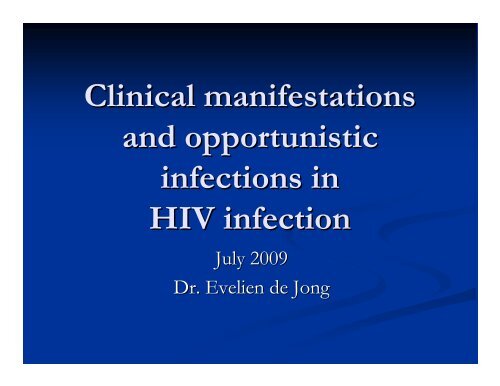
![Klinische les - Health[e]Foundation](https://img.yumpu.com/22210388/1/190x143/klinische-les-healthefoundation.jpg?quality=85)
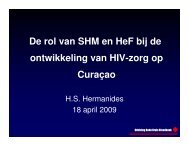
![TB/HIV Coinfection - Health[e]Foundation](https://img.yumpu.com/22210376/1/190x143/tb-hiv-coinfection-healthefoundation.jpg?quality=85)
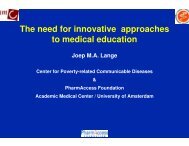
![ALTIJD EXTrA VOOrDELIG! - Health[e]Foundation](https://img.yumpu.com/22210346/1/177x260/altijd-extra-voordelig-healthefoundation.jpg?quality=85)

![Filmpje BoBo - Health[e]Foundation](https://img.yumpu.com/22210332/1/190x146/filmpje-bobo-healthefoundation.jpg?quality=85)
![Infeksi HIV pada Anak - Health[e]Foundation](https://img.yumpu.com/22210326/1/190x143/infeksi-hiv-pada-anak-healthefoundation.jpg?quality=85)
![Introduction on HIV - Health[e]Foundation](https://img.yumpu.com/22210322/1/190x146/introduction-on-hiv-healthefoundation.jpg?quality=85)
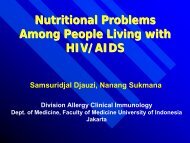

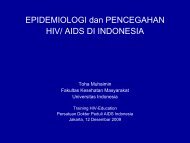
![Opportunistic infections - Health[e]Foundation](https://img.yumpu.com/21788230/1/190x146/opportunistic-infections-healthefoundation.jpg?quality=85)